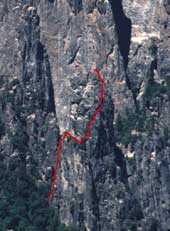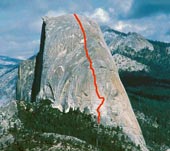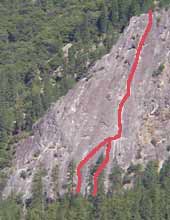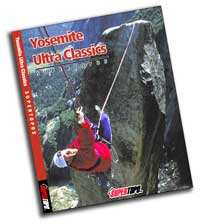|
January
2002
Bold
School
Five of Yosemite's Most
Classic Climbs
 |
From
left to right: Justin Bastien on Royal Arches, Tom Frost rappeling
Lower Cathedral Spire at sunset, and the spectacular view of
Yosemite Valley from atop the summit of Higher Cathedral Spire. |
| |
|
|
Not so long ago,
Yosemite climbers relied on belay systems that might
hold a fall, carpentry nails for protection and shoulder stands—not
bolts—to bypass blank sections. The techniques and equipment
from the 1930s would horrify a modern climber: These were
truly the days of “the leader must not fall.”
Not many of us
know what it was like to friction climb in tennis shoes without
a harness and with a hip belay or make overhanging rappels
using the Dülfer rappel method (with the rope wrapped
under the groin and over the shoulder). Today, climbers can
choose from a stunning selection of ultra-strong gear and
even download detailed route topos from the Internet. In addition
to these high-tech advantages, a modern climber who starts
a Yosemite classic knows that hundreds of others have gone
before him, and lived to spray about it.
Despite the advantages
a new-school climber enjoys, Yosemite’s towering granite
walls are still a worthy challenge. Even though we have the
luxury of knowing the rope will hold us if we fall, the exposure
and views are just as mind-blowing as they were on the first
ascent. These climbs remain the pinnacle of achievement for
any average Joe and anyone who does them will be psyched.
Even after numerous
ascents up the Big Stone, the Regular
Route on Higher Spire grabbed my attention. Following
the last pitch, I traversed under a large roof to face 1000
feet of stomach-turning exposure. Moving timidly up the
wild 5.8 arete to the summit, it was a relief that my
belayer Randy Spurrier was out of sight and could not see
my death grip on the final holds. Make no mistake, these
climbs are moderate, not easy.
Because I knew
the history of the route, the climbing experience was enriched.
Rather than an aesthetic looking rock with some good climbing,
my ascent of Higher
Cathedral Spire became a reenactment of a chapter in history.
And unlike a roped-off museum display, I was able to jam,
crimp and summit this piece of history.
|
|
|
Higher
Cathedral Spire II 5.9
It was the pinnacles, not the big faces, that appealed to
early Yosemite climbers, therefore, the Higher
Cathedral Spire, the tallest freestanding spire in North
America, was a natural attraction.
The first attempt
made in 1933 by Jules Eichorn, Bestor Robinson and Dick Leonard
was well-planned, yet lacked essential technology: they had
10-inch nails instead of pitons. This problem was solved the
following year with a hefty supply of “state-of-the-art”
gear: 55 pitons specially ordered from Europe, 13 carabiners,
manila hemp ropes and tennis shoes. The ascent was cutting-edge
in many ways: it featured one of the earliest uses of a pendulum
and was at the highest freeclimbing and aid climbing standards.
Sixty-seven years
later, Higher
Cathedral Spire remains a challenge. Unlike most rock
in Yosemite, the Southwest Face contains numerous face holds
and fractured, loose rock. The wild and exposed moves around
the “Rotten Chimney” are terrifying even with sticky
rubber and cams. Imagine navigating this pitch with tennis
shoes and ropes made of manila hemp.
|

Higher
Cathedral Spire, 5.9. |
|
Lower
Cathedral Spire – II 5.9
Though not as classic as its neighbor, Lower
Cathedral Spire is a must-do for any historical trophy
collector. Only months after climbing Higher Spire, the same
team returned to Lower Spire and started up the Southeast
Face. The route turned out to be less sustained than the Higher
Spire but more risky due to one large feature on the third
pitch: a menacing, thin flake detached ten inches from the
wall. The mindset necessary to climb the flake bordered on
insanity. First, a sharp projection on the flake was lassoed.
Then the rope, hanging vertical, was climbed hand-over-hand
until it was possible to mantel the projection. If liebacked,
the fragile flake would have broken so out came the hammer.
The leader then delicately chipped footholds into the flake
while balancing his weight in an effort to keep from pulling
the feature—and himself—from the wall. This was
Yosemite’s first instance of chipping, a practice that
was not repeated until the sport-climbing boom in the 1980s.
Today, even with
the security of modern equipment, the detached flake looks
suicidal and all climbers avoid the original direct line with
a variation to the right. The rest of the route does not have
any magnificent pitches, however, the summit and overall experience
make this a worthy outing.
|

Lower
Cathedral Spire, 5.9. |
|
Royal
Arches – III 5.10b or 5.7 A0
With the major Valley spires climbed, the pioneers of the
1930s turned to the unclimbed faces. Climbing Half Dome and
El Capitan was unthinkable. The 1400-foot Royal
Arches, however, was covered with just enough features
and ledges to forge a route.
While the first
part followed large, 4th class ledges, the upper half of the
route looked more challenging. The first difficulty, encountered
halfway up the wall, was a 10-foot blank section that was
overcome by using a “swinging rope traverse.” Even
today, 99% of climbers pendulum rather than free climb the
desperate 5.10b slab moves. A few pitches later, the climbers
encountered the second major difficulty: a gap separating
the major features. Miraculously, a dead tree trunk had formed
a perfect, albeit terrifying bridge. This feature, dubbed
“The Rotten Log”, sadly departed from the wall in
1984, removing the most classic and frightening part of the
climb. Not to worry, the route still has plenty of exciting
sections, most notably the last pitch. Here, with the easy
walk-off agonizingly close, the team faced a 50-foot blank
section covered in pine needles. Pushing the limits of friction
on polished granite with tennis shoes, the first ascentionists
pulled through a section that dismays many present-day climbers
using sticky rubber.
|

Royal
Arches, 510b or 5.7 A0. |
|
Steck
Salathé – IV 5.9
Unlike most large faces, there was no mystery in piecing together
the line that would take John Salathé and Allen Steck
up the North
Face of Sentinel: wide cracks and gaping chimneys cut
up the face from bottom to top. While such an obvious line
meant few routefinding problems, it also meant wide climbing
and lots of it.
Steve Roper refers
to the time period around the first ascent as the “technical
age.” By today’s standards, however, Salathé
and Steck used archaic gear. On a climb filled with wide cracks,
the largest piton they had were only an inch wide. They also
carried the old-school ration of water: one quart per person
per day. The climb was so difficult that Steck wondered if
there would ever be a second ascent.
Today, the route
is popular, though still considered a stout outing. For all
but the honed off-width climber, the route is solid and terrifying
5.9.
|

Steck-Salathe,
5.9. |
|
Snake
Dike – III 5.7 R
When Eric Beck, Jim Bridwell and Chris Fredericks returned
from the first ascent of Snake
Dike, the Camp 4 climbers were in disbelief. These climbers
had put up a new 800-foot route in a day from Camp 4 to Camp
4 and proclaimed the route trivial. At the time, only one
other route graced the face: the challenging 5.10b R southwest
face. According to Steve Roper, “disdain [from other
Camp 4 climbers] evolved to thoughts that the three men should
be committed.”
But, Snake Dike
first ascentionists were telling the truth. They had climbed
one of Yosemite’s most wild features: a 600-foot-long
vertical dike that rarely was harder than 5.4. Part of the
reason the team moved so fast was that they didn’t bother
to place much pro: on the entire eight-pitch climb, only six
bolts and two pitons were placed---including belays!
Fearing that they
had put up a death route for beginners, the first ascent team
gave the second ascentionist, Steve Roper, permission to add
bolts. Few modern day climbers will complain about the added
bolts as almost every pitch has a huge 5.4 runout and some
pitches have no protection at all.
|

Snake
Dike, 5.7R. |
|
Nutcracker
– III 5.8
Like most Valley climbers, Royal Robbins did not instantly
embrace nuts. For a time, nuts were thought to only be useful
in England and not the parallel-sided cracks of Yosemite.
However, after experiencing the utility and non-destructive
quality of nuts in England in 1966, Royal returned to Yosemite
a believer. Not only did he accept nuts, he set out to influence
others to stop the destructive use of pitons. What better
way to encourage nut use than to climb a first ascent using
nothing but nuts?
Not only did Royal
and his wife Liz put up a climb using solely nuts, they put
up perhaps the best multi-pitch 5.8 in Yosemite. After their
first ascent of Nutcracker Sweet (later shortened to Nutcracker),
virtually all climbers who followed only used nuts. This act
along with the 1972 Chouinard Equipment Catalog and the first
hammerless ascent of Half Dome’s Northwest Face, would
seal the fate of pitons forever.
|

Nutcracker
offers two starting lines. The right line is 5.9. The normal
start is 5.8. |
|
Details
Yosemite Valley has all the good and bad that comes with an
urban destination. The good news is that if your car breaks
down or you’re craving Filet Mignon, Yosemite has you
covered. The bad news is that it is hard to escape the car
traffic and tourists. The Valley is relatively empty from
November to April but unfortunately most long routes will
be unclimbable.
For the most detailed
topos for these routes, check out the “Yosemite
Ultra Classics” guide from Supertopo.com. Each route
comes with a detailed topo, route history by Steve Roper and
strategy section.
Many climbs require
an alpine start to avoid the crowds. Of the routes covered
here, only Royal
Arches has enough variations to easily pass slower parties.
The best time to climb these routes is in the spring and fall.
About the only time Royal Arches does not have crowds is in
the winter and early spring when much of the route runs with
water. The wet rock is not bad if you remember this key bit
of advice: take off your shoes to get better friction.
During the summer,
you will have to start at dawn to avoid the heat, especially
on the Cathedral Spires and Nutcracker. If the Valley is sweltering,
consider heading to a great swimming hole about 10 miles west
of the Highway120 entrance station. You can choose whether
to jump off the 15-foot or the 25-foot cliff. Check out the
Supertopo.com Yosemite
page for directions to get here and other swimming holes.
Other rest day
activities include filling up the cooler, renting a raft from
Curry village and floating down the Merced River. Or just
head down to El Cap meadow with a pair of binoculars and either
watch climbers or pick out the next new squeeze job (there
are still a few 50-foot sections of unclimbed rock).
If you arrive
in Yosemite in the summer, chances are Camp 4 will be full.
If you are having trouble getting a site, consider camping
next to the Merced River outside west of El Portal or at any
of the other park entrance stations. There is also more information
on extra camping on the SuperTopo Yosemite
page.
|

Yosemite
Ultra Classics provides detailed topos on Yosemite's most
classic climbs including all five of these classics, and many
more.
|
|
Chris
McNamara is the founder of SuperTopo. This article was orginaly
published in Rock and
Ice Magazine.
|
|
|